How to Choose the Right Fabric for my Sewing Project
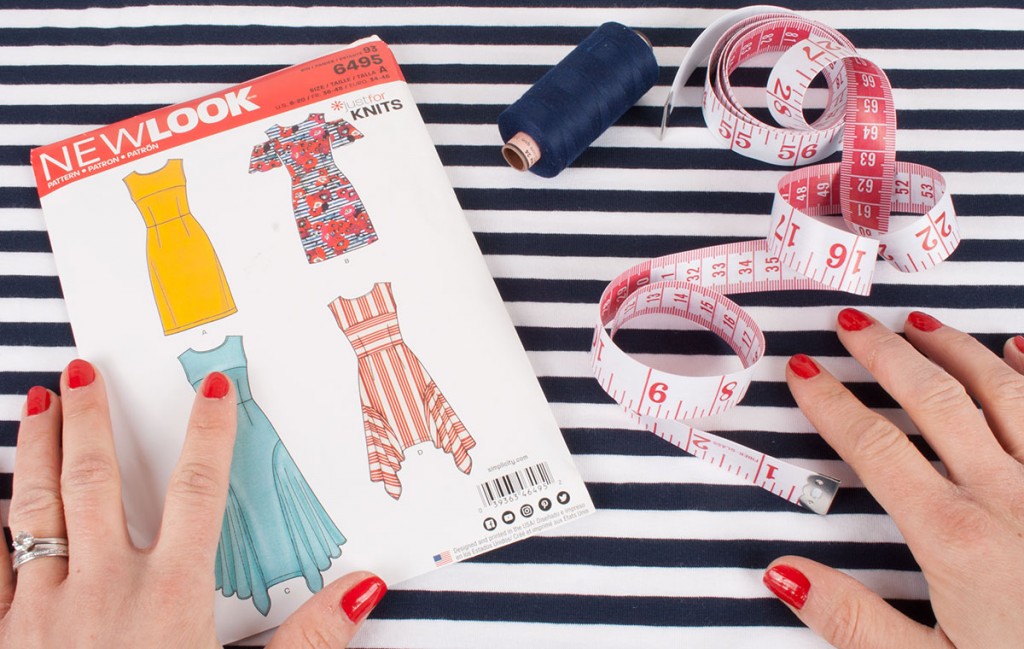 Put simply choosing the right dressmaking fabric can make or break your sewing project. A number of customers have told us they struggle with this aspect of dressmaking so we've written this guide to help you along the way. Fabric shopping should be nothing but a purely joyful experience after all! Plus we want you to reap the rewards of the time and money you invest in every project.
Put simply choosing the right dressmaking fabric can make or break your sewing project. A number of customers have told us they struggle with this aspect of dressmaking so we've written this guide to help you along the way. Fabric shopping should be nothing but a purely joyful experience after all! Plus we want you to reap the rewards of the time and money you invest in every project.
The Basic Logic behind Fabric Choice
Trying to get your head around fabric types can feel totally overwhelming. Even experienced dressmakers can feel this way and stick to what they know to avoid disappointment. Understanding which fabrics work well for different garments can also help you to become a more adventurous sewer. Before you start to think about a specific project it is a good idea to get a basic grasp of what makes different fabric types suited to different garments. You can start to do this by looking at the clothes in your wardrobe. Think about why each type of fabric is suitable for each particular garment. Don't worry if you're not sure exactly what type of fabric it is, we will cover these in more detail later.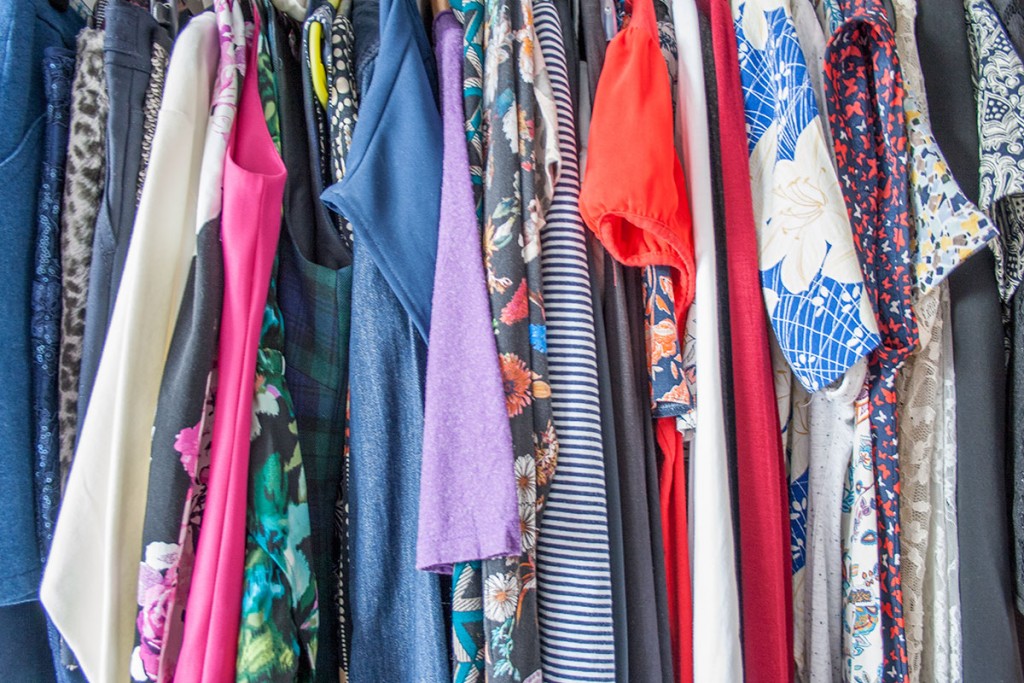 Think about the characteristics of the garment rather than the type of garment. When choosing fabric the style, fit, design, silhouette and structure you want to achieve are important considerations. We would argue how the fabric hangs or drapes is the crucial starting point.
It is impossible to allocate a fabric type to a garment type. For example, you could say all jackets should be made from a stiff fabric to achieve the necessary structure. Whilst this might be true for a formal suit jacket, it would not be the case for a casual cardigan style jacket or a loose fitting rain jacket such as the second and third images below.
Think about the characteristics of the garment rather than the type of garment. When choosing fabric the style, fit, design, silhouette and structure you want to achieve are important considerations. We would argue how the fabric hangs or drapes is the crucial starting point.
It is impossible to allocate a fabric type to a garment type. For example, you could say all jackets should be made from a stiff fabric to achieve the necessary structure. Whilst this might be true for a formal suit jacket, it would not be the case for a casual cardigan style jacket or a loose fitting rain jacket such as the second and third images below.
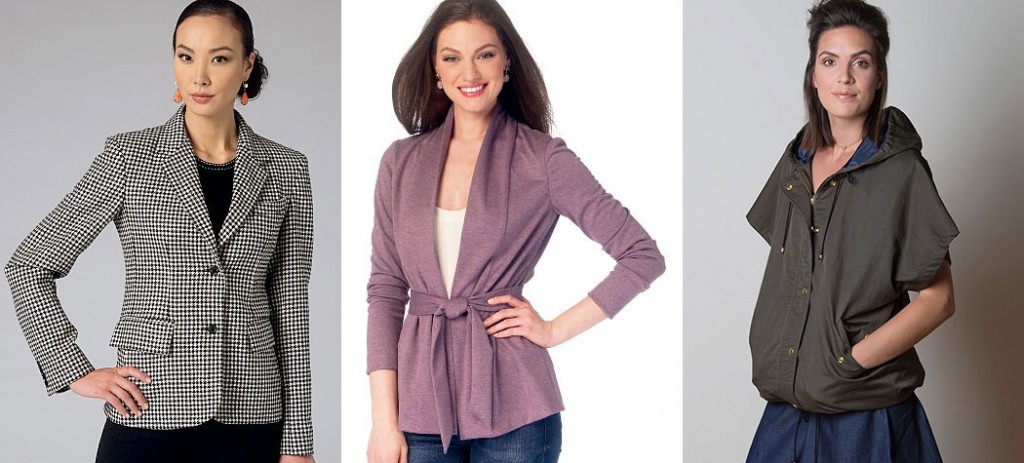 First ascertain the drape - is it a structured silhouette or a fluid one that flows over the body? Then start to ask yourself further questions - is the garment close fitting and therefore needs to stretch as you move? Does it need to be an opaque fabric - most people wouldn't fancy wearing a sheer skirt or trousers! Does the fabric need to be strong enough to take stress on the seams? To avoid a split pair of trousers for example!
Choosing the right fabric for a project is a process of elimination - identifying and ruling out fabrics that won't work until you have a list of possible options that will. The above questions will help you to do just that.
Now turn your thinking on its head. Think about why the clothes you've considered wouldn't work as well in different fabrics. Imagine a nice crisp cotton shirt made in a drapey, fluid fabric such as satin or chiffon. Imagine a flowing maxi dress in a stiffer, coarser fabric. Then save yourself the horror of the pictures in your mind's eye and stop imagining!
Once you have considered your existing clothes and have a feel for the key questions to ask yourself you can start to think about what you would like to make.
First ascertain the drape - is it a structured silhouette or a fluid one that flows over the body? Then start to ask yourself further questions - is the garment close fitting and therefore needs to stretch as you move? Does it need to be an opaque fabric - most people wouldn't fancy wearing a sheer skirt or trousers! Does the fabric need to be strong enough to take stress on the seams? To avoid a split pair of trousers for example!
Choosing the right fabric for a project is a process of elimination - identifying and ruling out fabrics that won't work until you have a list of possible options that will. The above questions will help you to do just that.
Now turn your thinking on its head. Think about why the clothes you've considered wouldn't work as well in different fabrics. Imagine a nice crisp cotton shirt made in a drapey, fluid fabric such as satin or chiffon. Imagine a flowing maxi dress in a stiffer, coarser fabric. Then save yourself the horror of the pictures in your mind's eye and stop imagining!
Once you have considered your existing clothes and have a feel for the key questions to ask yourself you can start to think about what you would like to make.
Consulting the Pattern Packet
Suggested Fabric Types
If you are starting with a particular pattern in mind look at the packet. It is full of interesting and useful information. If there is a photograph on the packet it can give you a clue as to the type of fabric that would be suitable. Look at the back of the pattern packet. There is usually a table with a list of a wide range of suitable fabrics. If you aren't confident about fabric choice it is best to stick to these, but as your confidence grows you may choose to select alternative fabrics to work with.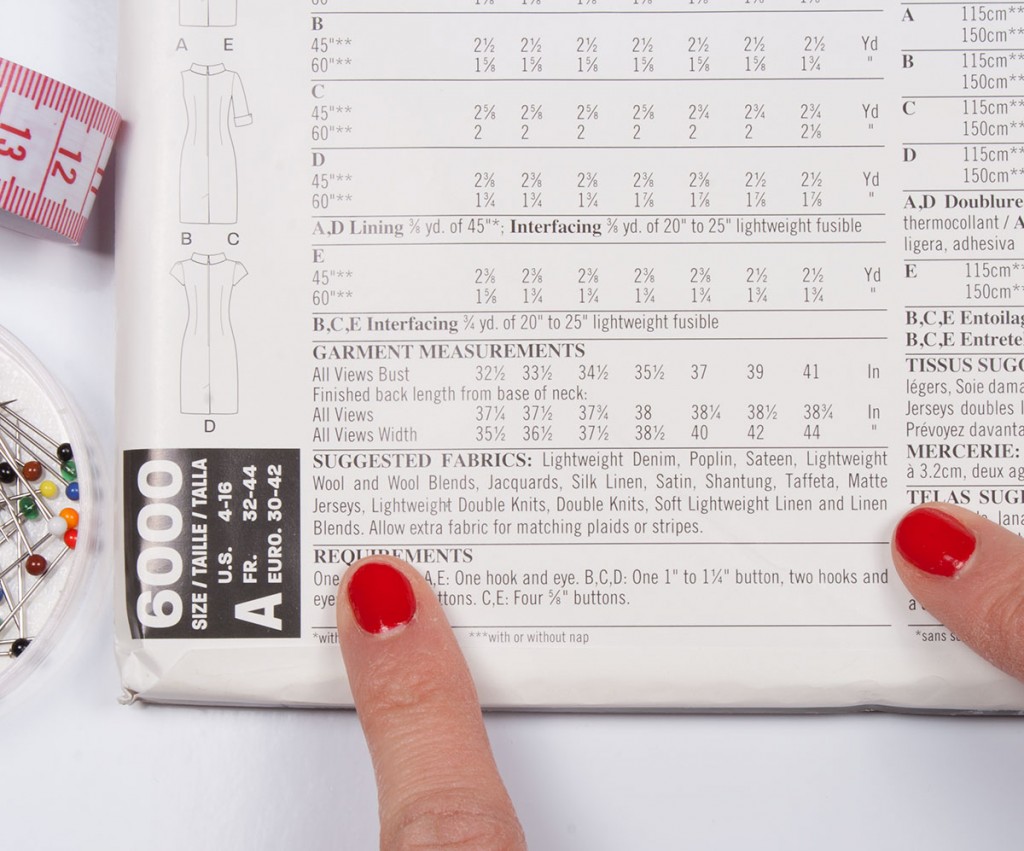
Knit Only Patterns
Some patterns will only be suitable for knit fabrics also referred to as stretch and jersey fabrics. These patterns are designed with negative ease i.e the finished garment will be slightly smaller than your measurements. This is because the garment is meant to stretch and hug your body. Using a fabric without enough stretch will result in a garment that is too tight or doesn't fit at all. Patterns designed for knits often have markings on the back of the packet so you can do a stretch test. For example here you take a section of fabric as long as the black bar and check it can be stretched to the arrow at the end of the white bar. If it stretches this far and returns back to it's original position afterwards (known as recovery) it should be fine.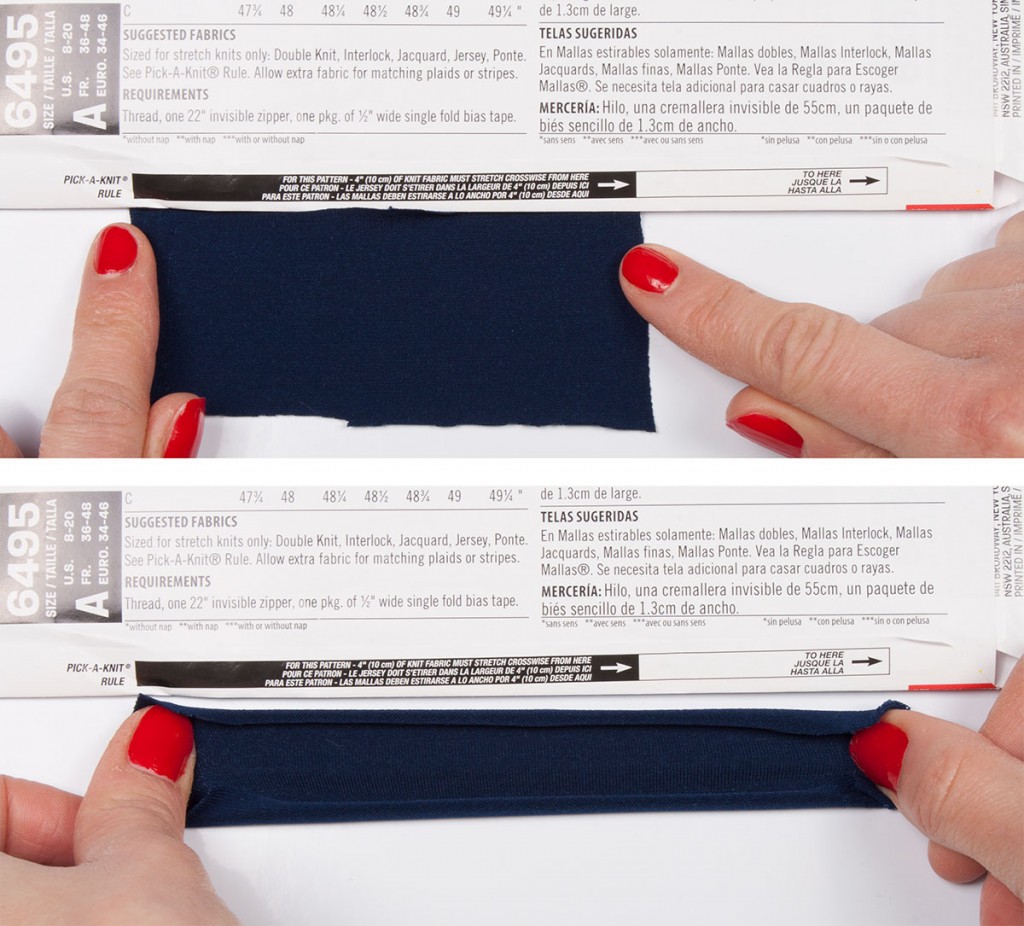 Equally using a stretch fabric for a non stretch pattern can result in a baggy, shapeless garment unless you make adjustments to the pattern. There are suggested formulae and methods recommended for making these alterations so it is best to do your research before attempting it.
It is also worth recognising that stretch fabrics can be two way stretch or four way stretch and certain patterns will only be suitable for one of these types. Two way stretch fabrics stretch width ways across your body (NB: the stretch of the fabric should always be across the body for two way stretch fabrics). Four way stretch fabrics also stretch lengthways and diagonally.
Equally using a stretch fabric for a non stretch pattern can result in a baggy, shapeless garment unless you make adjustments to the pattern. There are suggested formulae and methods recommended for making these alterations so it is best to do your research before attempting it.
It is also worth recognising that stretch fabrics can be two way stretch or four way stretch and certain patterns will only be suitable for one of these types. Two way stretch fabrics stretch width ways across your body (NB: the stretch of the fabric should always be across the body for two way stretch fabrics). Four way stretch fabrics also stretch lengthways and diagonally.
Fabric Quantities
The pattern packet also tells you whether plaids, stripes or one directional prints are suitable and if extra fabric is necessary to pattern match these fabrics. There is no general rule of thumb for how much extra fabric you will need. It depends on the size of the print and the pattern. The pattern packet will also tell you how much fabric you will need based on the width of the fabric. Dressmaking fabrics are usually 45" (115cm) or 60" (150cm) wide so you will need to buy slightly less if the fabric you have chosen is wider.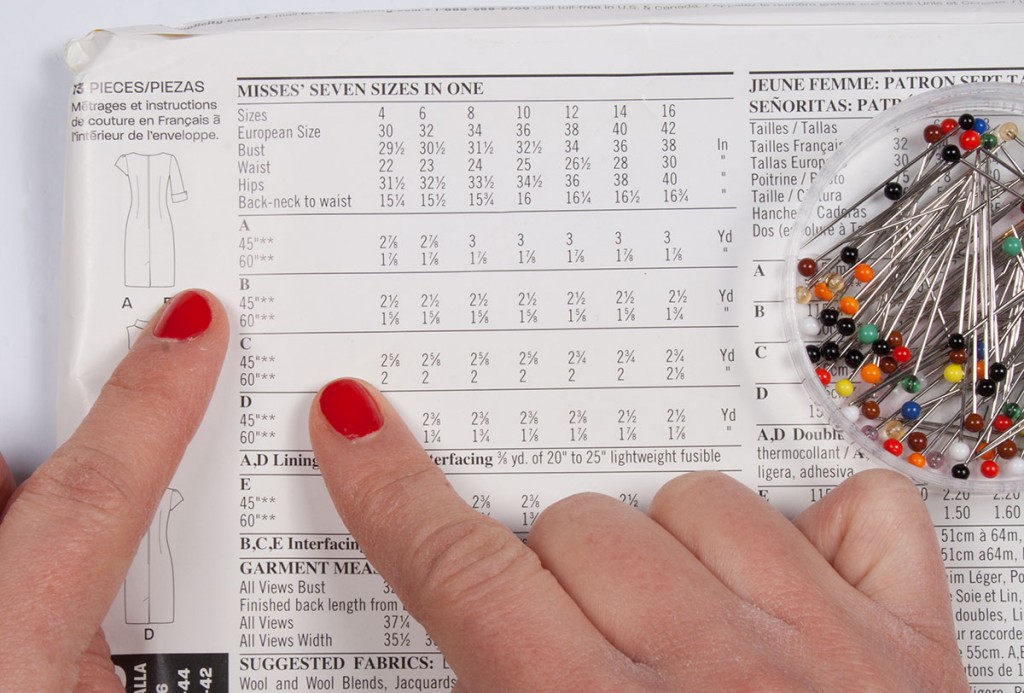 Even if you are starting with a fabric in mind rather than a pattern use the logic we have applied. Refer back to the questions above to identify a suitable garment to make with it.
Even if you are starting with a fabric in mind rather than a pattern use the logic we have applied. Refer back to the questions above to identify a suitable garment to make with it.
Common Fabrics used for Garments
The first thing I should mention is our website. We've broken the fabrics down into fabric types so it is nice and easy to find what you are looking for. In the largest fabric section (patterned woven fabrics) we've added filters to assist you further. You can select fabric type and/or print design to help you to narrow things down. I have used our website fabric groupings to prepare this list to make it even easier to navigate your way around. This method of grouping also works well for the process of elimination method we talked about earlier. It is by no means an exhaustive list, but covers most of the common dressmaking fabric types.|
FABRIC GROUP |
FABRIC TYPES |
DRAPE |
CHARACTERISTICS & COMMON USES |
SEWABILITY |
|
COTTON |
Cotton poplin |
Limited drape |
Natural fibre, light to medium weight, skirts, shirts, dresses |
Easy |
|
Cotton lawn |
Very good drape |
Lightweight, skirts, blouses, dresses, shirts |
Easy |
|
|
Polycotton |
Limited drape |
Polyester and cotton blend, medium weight |
Easy |
|
|
Cotton sateen |
Drape varies dependant on weight. |
Satin finish, sometimes has a small amount of stretch, skirts, trousers, dresses |
Easy |
|
|
CHIFFON |
Silk chiffon, nylon chiffon and polyester chiffon |
Excellent drape. |
Lightweight, sheer, lingerie, sleepwear, overlay on evening dresses or blouses, scarves | Advanced |
|
LINEN |
Linen |
Good drape. |
Natural fibre, cool and absorbent. Trousers, skirts, blouses, jackets |
Easy |
|
POLYESTER |
Poly-viscose, 100% polyester |
Good/very good drape |
Skirts, dresses, trousers |
Intermediate - can be slippery |
|
Crepe de chine |
Excellent drape |
Silk like appearance (silk based also available), very lightweight, blouses, lingerie, scarves |
Intermediate - can be slippery | |
|
Crepe |
Excellent drape |
Various weights available, satin backed options available. Tops, skirts, dresses |
Intermediate - satin backed option can be slippery | |
|
VISCOSE |
Poly-viscose, ramie-viscose |
Excellent drape |
Natural fibres, often blended with other fibres, dresses, tops, skirts |
Intermediate - can be slippery |
|
KNITS |
Cotton jersey & wool jersey |
Excellent drape |
Matt finish stretch fabric, tops, skirts, dresses |
Intermediate - correct tools & handling necessary |
|
Polyester jersey & viscose jersey |
Excellent drape |
Sheen finish stretch fabric, tops, skirts, dresses |
Intermediate - correct tools & handling necessary | |
|
Scuba |
Firm knit, no drape |
Suitable for skirts, dresses, jackets |
Intermediate - correct tools & handling necessary | |
|
DENIM |
Stretch denim available in a range of weights |
Firm weave, limited or no drape |
Stretch fabric, lighter weights suitable for dresses, shirts, skirts, heavier weights for trousers, jackets, coats |
Intermediate |
|
Non stretch available in a range of weights |
Firm weave, limited or no drape |
Lighter weights suitable for dresses, shirts, skirts, heavier weights for trousers, jackets, coats |
Easy |
|
|
LACE |
Available in stretch and non stretch |
Excellent drape |
Decorative fabric used for dresses, tops, skirts and lingerie |
Advanced |
|
SATIN |
Polyester or silk based |
Drape varies depending on weight |
Luxurious fabric used for evening wear, blouses, dresses |
Advanced - very slippery! |
|
TAFFETA |
Silk, rayon or polyester available |
Firm weave, limited drape |
Luxurious fabric used for evening wear |
Intermediate |
|
VELVET |
Silk, rayon, cotton, viscose, polyester blends available |
Excellent drape |
Short dense pile - smooth brushed in one direction, coarse in the other. Luxurious fabric, dresses, tops, jackets, trousers, skirts |
Advanced |
|
WOOL |
Boiled wool, worsted wool, wool crepe, wool jersey |
Drape varies depending on weight |
Trousers, dresses, skirts, coats, jackets depending on weight |
Specialist preparation & pressing required |
